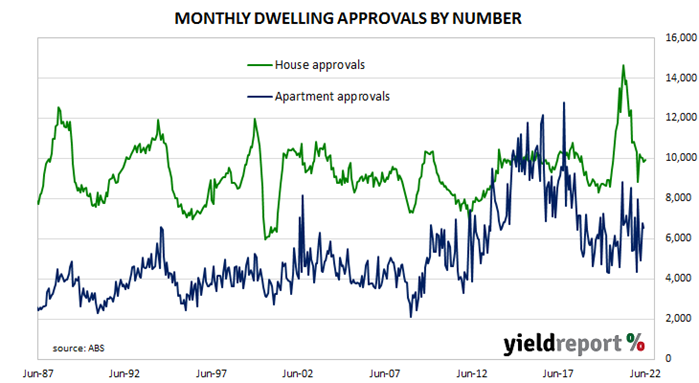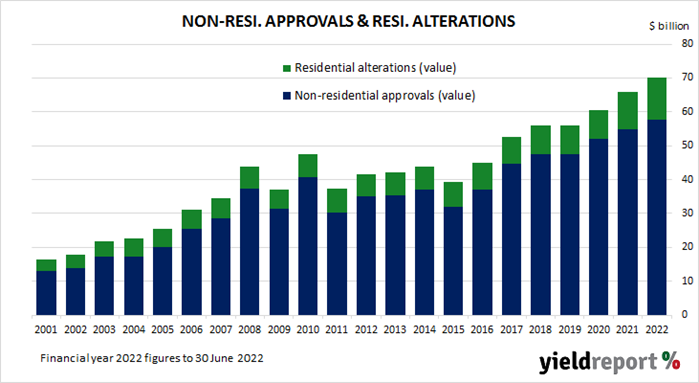Summary: Home approval numbers down 0.7% in June, above expectations; strong growth in Victoria offset by declines in Qld., SA; “significant hit still looms” from rising costs, interest rates; accelerating population growth “should support total residential approvals” beyond 2022; house approvals up 0.9%, apartments down 3.1%; non-residential approvals down 6.1% in dollar terms, residential alterations down 2.2%.
Building approvals for dwellings, that is apartments and houses, had been heading south since mid-2018. As an indicator of investor confidence, falling approvals had presented a worrying signal, not just for the building sector but for the overall economy. However, approval figures from late-2019 and the early months of 2020 painted a picture of a recovery taking place, even as late as April of that year. Subsequent months’ figures then trended sharply upwards before falling back in 2021 and the first half of 2022.
The Australian Bureau of Statistics has released the latest figures from June and total residential approvals declined by 0.7% on a seasonally-adjusted basis. The fall over the month was higher than the 5.0% decrease which had been generally expected but it contrasted with May’s 11.2%. Total approvals fell by 17.2% on an annual basis, slightly higher than the previous month’s revised figure of -20.0%. Monthly growth rates are often volatile.
“There was considerable variation across states, with very strong growth in Victoria offset by declines in Queensland and South Australia,” said ANZ senior economist Adelaide Timbrell.
Commonwealth Government bond yields fell significantly on the day, to some degree following the falls of US Treasury yields overnight. By the close of business, the 3-year ACGB yield had lost 9bps to 2.74%, the 10-year yield had shed 12bps to 3.00% while the 20-year yield finished 6bps lower at 3.37%.
“Overall, it still looks like just a matter of time before the pressure from rising costs and interest rates impacts new dwelling approvals. The June quarter may have held up much better than expected but a significant hit still looms,” said Westpac senior economist Matthew Hassan.
ANZ’s Timbrell appeared somewhat more optimistic, at least in the medium-term. “Beyond 2022, accelerating population growth, as immigration recovers to near pre-pandemic rates, should support total residential approvals and reduce the risk of a ‘cliff’ in construction activity.”
Approvals for new houses increased by 0.9% over the month after declining by 1.8% in May. On a 12-month basis, house approvals were 22.1% lower than they were in June 2021, up from May’s comparable figure of -29.2%.
Apartment approval figures are usually a lot more volatile and June’s total slid by 3.1% after a 37.6% jump in May. The 12-month growth figure deteriorated from May’s revised rate of -1.3% to -8.4%.
Non-residential approvals decreased by 6.1% in dollar terms over the month and by 8.4% on an annual basis. Figures in this segment also tend to be rather volatile.
Residential alteration approvals decreased by 2.2% in dollar terms over the month and were 0.7% lower than in June 2021.



